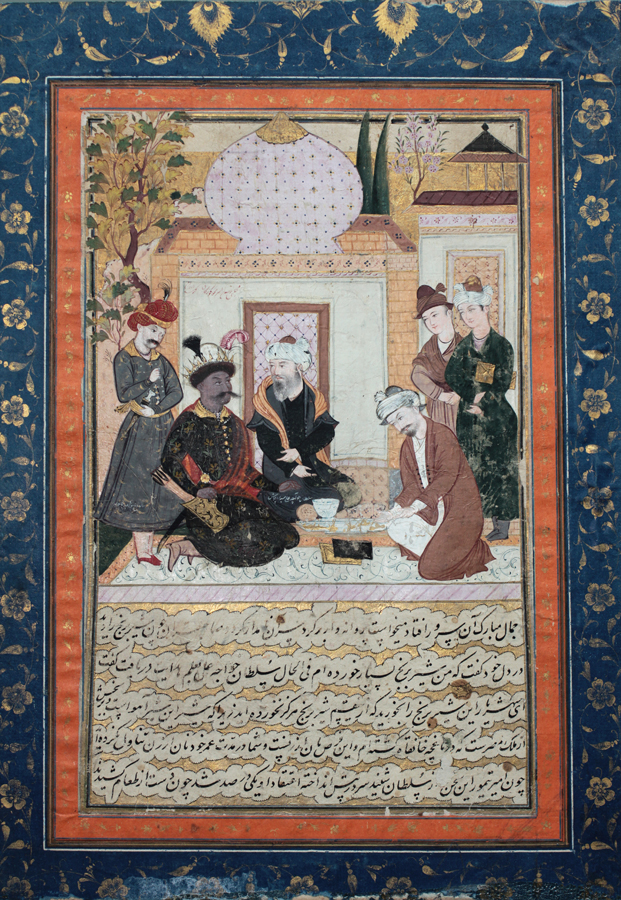Location: Private Collection
Mount: blue mount with gold decoration; orange collar. Mount size:: 31 x 22.8 cm
Written surface: 23.2 x 14.8 cm. (scaled)
Painting: 16 x 14.8 cm.
Text references: J.K., p.30 line 11 to p.31 line 2
(with minor revisions to text)
See Savory, SA_1979, p27-28 for this event in the History of Shah ʿĀbbās.
Date of this event: 803/1404.
This event allegedly took place several years after the incident in which Ḵˇāja ʿAli returned the Timur's whip (see ms.M, f.17), when Timur was returning from his campaign in Asia Minor with a large number of prisoners. The fame of Shaikh Ṣafi’s shrine was widespread, and Timur stopped at Ardabil to make a pilgrimage to the Safavid mausoleum. When Timur questioned the attendants, the darvishes directed him to Ḵˇāja ʿAli’s private quarters, only to find him at prayer. Upon completion of his prayers, Ḵˇāja ʿAli had the conqueror seated in the proper manner, and offered him words of counsel and admonition. In response, Timur vowed to commit himself to the Ḵˇāja’s spiritual direction, if the mystic could reveal three things of which the emir was thinking. Ḵˇāja ¯Ali successfully revealed all three things, prompting Timur to offer him any request (Different versions are given by different sources - see Savory, Development, p.23). Since Ḵˇāja ʿAli was completely free of worldly considerations, he requested that Timur release all his prisoners. Timur complied, and with his own money bought pasture land for them in the area of Ardabil, and presented it as a vaqf to the Safavid sanctuary.
The painting illustrates the meeting of Timur and Sultan Ḵˇāja ʿAli in the latter’s private quarters. The bearded Ḵˇāja, clad in gray with a white turban, is seated in front of a domed, tiled, hexagonal pavilion of pastel colors. He looks in the direction of Emir Timur who kneels before him. Timur is portrayed dark-skinned in the traditional representation of an Indian. Behind Timur stands his son, Shah Roḵ. Off to the right are three attendants; one kneels with a paper and ink before him drafting a document.
Inscriptions: In white identifying two of the particpants, Sultan ʿAli Siāh Puš and šāh roḵ ebn-e amir timur. Another inscription in red on the face of the facade in the upper left, majles-e rasidan amir timur-e gurāḵān ba hedmat-e darviš̯̯ (?)
Painting references:
Christie's London, 11 October 2005, Lot 103
Provenence: Purchased 2005 at Christies by the present owner.
Photo courtesy of present owner.
Robert Eng
Last Updated: January 26, 2013 | Originally published: January 22, 2013
